Santa Rosa de Lima (Abiquiu, New Mexico) facts for kids
|
Santa Rosa de Lima de Abiquiu
|
|

Ruins of church, Santa Rosa de Lima. The church was still in use until the 1930s. 2010 photo.
|
|
| Nearest city | Abiquiú, New Mexico |
|---|---|
| Area | 12.5 acres (5.1 ha) |
| Built | 1734 |
| NRHP reference No. | 78001820 |
Quick facts for kids Significant dates |
|
| Added to NRHP | April 14, 1978 |
Santa Rosa de Lima was an old Spanish village built in the early 1700s. It was located in the Rio Chama valley, in what is now New Mexico, United States. This historic site is close to the modern town of Abiquiu.
Contents
A Spanish Settlement in New Mexico
In the 1730s, Spanish families began moving into the Chama River valley. By 1744, about 20 families had settled in the area. They built a village they called Plaza de Santa Rosa de Lima.
The Church and Early Life
The village had a church, built around 1744. People used this church for worship until the 1930s. Life in the settlement was likely focused on farming and community.
Why the Village Was Left Behind
The settlers faced many challenges. Ute and Comanche groups often raided the village. These attacks made it very difficult and dangerous to live there. Because of these repeated raids, the people had to leave Santa Rosa de Lima in 1747.
Three years later, in 1750, the Spanish started a new settlement. This new village was built about a mile away from the old site. It is where the town of Abiquiú stands today.
Santa Rosa de Lima Today
Today, Santa Rosa de Lima is a ghost town. This means it's a place where people used to live but don't anymore. You can still see the large ruins of the old church. These ruins are made of adobe, a type of sun-dried brick. There are also mounds of earth where the settlers' adobe houses once stood.
A Protected Historic Site
The land where Santa Rosa de Lima is located is private property. It belongs to the Archdiocese of Santa Fe. In 1978, Santa Rosa de Lima de Abiquiu was added to the National Register of Historic Places. This means it's an important historical site that is protected. Its special number on the register is 78001820.

